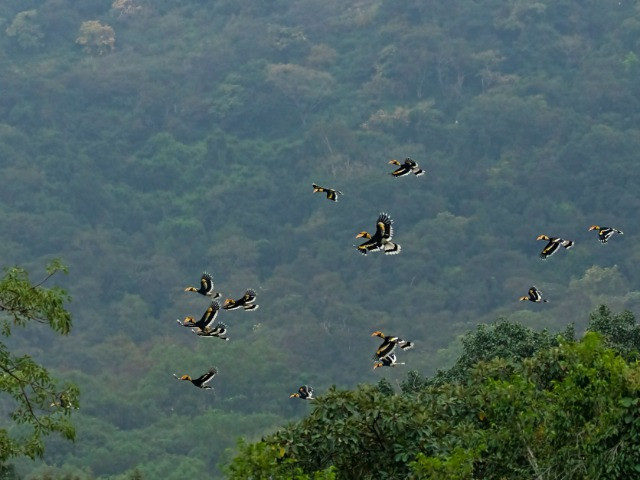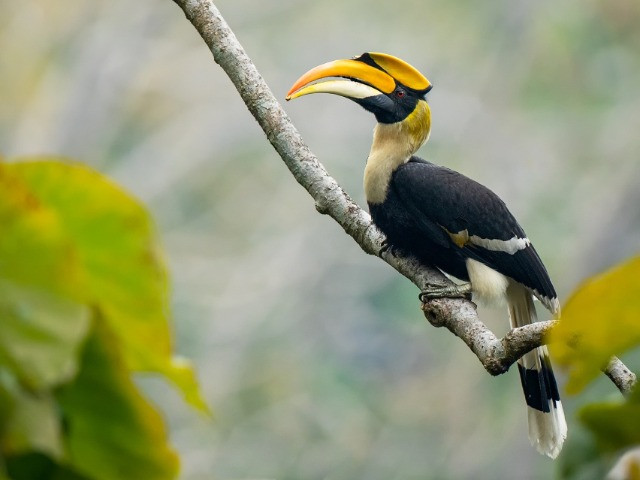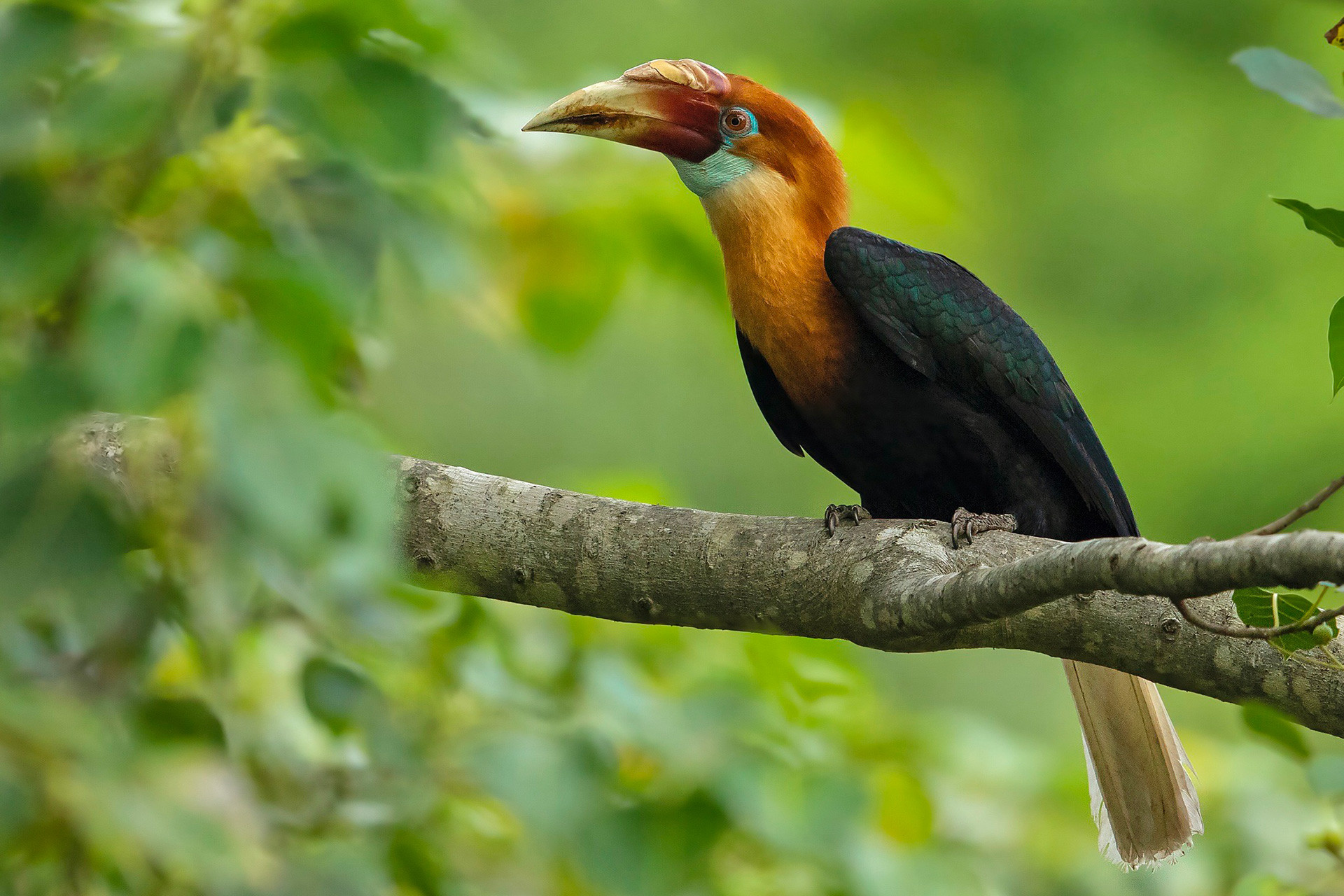Earlier this year, a video surfaced on Twitter showing two Indian Grey Hornbills perched on the railing of a balcony in an apartment complex in Mumbai, Maharashtra. The video, which went viral and was liked and shared widely, elicited mixed responses. While some people commented and asked about the name of the species, others seemed to be awed by the fact that such birds exist amidst the city's sprawling urban jungle. Ironically, Indian Grey Hornbills are one of the most common resident hornbill species of the Indian subcontinent. Although they have managed to adapt to the urban landscape (they have also been observed to feed on discarded food), reactions to the video prove that awareness about hornbills, in general, is not that high.
Charismatic, enigmatic, rare; call them what you may, hornbills are truly some of the most captivating avians on the planet. Their distinct calls, disproportionately large beaks, long eyelashes, prominent casques, unique courtship rituals and the striking colours that some hornbill species exhibit make them a birdwatcher’s delight.
There are about 62 hornbill species world-over of which nine reside in India. It is difficult to estimate the number of hornbills in the country, but a citizen science initiative launched by the Nature Conservation Foundation (NCF) recorded about 938 hornbill sightings across India on their website as of February 2017. Hornbills play a vital role in forest regeneration and are therefore called 'farmers of the forest'. They are omnivores, but they have a preference for fruits, particularly figs. "They are known to disperse seeds and aid in the regeneration of tropical trees by enabling the seeds to escape from competition with the parent plant and siblings, as well as from the predation of rodents, invertebrates and fungi that they would otherwise experience under the mother plant," writes scientist Rohit Naniwadekar on the seed dispersal mechanisms of hornbills.
If you are a regular visitor to the Nature inFocus portal, then you know that we do have a special corner for them on our website. In the past, we have shared ten interesting facts about hornbills, introduced you to the Hornbill Nest Adoption Programme, given you a glimpse of the breeding habits of Indian Grey Hornbills, as well as the elaborate courtship displays of other species while also taking you into the world of the hornbills of Valparai. We may have a lot to say about hornbills, but it is never enough when it comes to emphasising the need to protect them and conserve their habitats. Borrowing from biologist Pooja Pawar on the subject, our only hope is that the Indian hornbills can one day soar, whoosh and cackle over the canopies without a threat around.
Here is a quick overview of the hornbills of India.
Great Hornbill (Buceros bicornis)
IUCN Red List Status: Vulnerable (Population decreasing)
The largest hornbill species in India, Great Hornbills are also called Great Indian or Great Pied Hornbills. In India they are mainly found in the foothills of the Himalayas and parts of northeast India, along with the Western Ghats. These striking birds measure 95 to 130cm in length and are identified by their black and white plumage and their large, curved beaks. The upper mandibles are bright yellow in colour with a distinct casque on top. In males, the casque has black markings towards the tip. Females have smaller-sized casques devoid of the black markings. Great Hornbills are found in tropical and subtropical montane, deciduous and evergreen forests. The density of the forest region correlates with the hornbill population of the area. Great Hornbills nest within natural cavities of large, old trees, especially those that rise above the canopy. Apart from deforestation and habitat fragmentation, their populations are also significantly impacted by hunting. Myths about the medicinal value of their meat and an interest in their large casques makes them frequent targets.
Rufous-necked Hornbill (Aceros nipalensis)
IUCN Red List Status: Vulnerable (Population decreasing)
Large hornbills that measure about 90 to 100cm in length, Rufous-necked Hornbills are residents of northeast India. As the name suggests, male hornbills have rufous-coloured head, neck and underparts, while females are predominantly black in colour. Both sexes have blue colouration around their eyes and red gular pouches. Rufous-necked Hornbills prefer evergreen broadleaved and deciduous forests as habitats. They build nests within tree hollows and prefer wide-girthed trees as breeding sites. As they depend on large trees for feeding and nesting, their populations are greatly impacted by deforestation and habitat fragmentation.
Wreathed Hornbill (Rhyticeros undulatus)
IUCN Red List Status: Vulnerable (Population decreasing)
Wreathed Hornbills are large birds that measure about 85cm in length. Male Wreathed Hornbills have a rufous-coloured head and crown and a distinct yellow gular pouch. Female hornbills have blue-coloured gular pouches, while their head and neck are black in colour. Hornbills use their gular pouches to store fruits, which they then consume over time while spitting out the seeds. Wreathed Hornbills have high forest dependency and are mainly seen in primary rainforests. In India, the species can only be sighted in the northeast. They build nests within tree holes and prefer deciduous trees for nesting. Destruction of forest land is one of the biggest threats to Wreathed Hornbills as they require vast forest areas for survival.
Oriental Pied Hornbill (Anthracoceros albirostris)
IUCN Red List Status: Least Concern (Population stable)
Predominantly black and white in colour, Oriental Pied Hornbills are similar in appearance to Malabar Pied Hornbills. Oriental Pied Hornbills measure about 60-70cm in length and male hornbills are larger than females. Apart from the difference in size, male and female hornbills can be distinguished by their bills and casque. Males have yellow bills with a large casque that has a black line-like colouration towards the end. In females, the casque is smaller with black markings at the end of the casque and the upper bill. In India, these birds are mainly found in the northeast, where they occupy moist deciduous and evergreen forests. They are seen in riverine regions and near forest edges. Being highly adaptable, Oriental Pied Hornbills are also found in gardens and near agricultural areas. Due to their ability to survive in a range of habitats, their population trend is stable.
You may also like to read
Malabar Grey Hornbill (Ocyceros griseus)
IUCN Red List Status: Vulnerable (Population decreasing)
Endemic to the Western Ghats, Malabar Grey Hornbills are comparatively smaller hornbills that measure about 60cm in length. The species can be identified by their brown-grey colouration with white streaks on their head and underparts, and their long, curved beaks. Females are slightly smaller than male hornbills. Malabar Grey Hornbills don't have large distinct casques like the other hornbill species. Males have small casques while females have a black colouration on their casques. They are known for their loud calls, often referred to as 'maniacal laughing' as it resembles a loud cackling noise. Apart from forest regions, Malabar Grey Hornbills have also been sighted in plantations within the Western Ghats. Conversion of forest area for agriculture and destruction of forest land are some of the biggest threats to the species.
Indian Grey Hornbill (Ocyceros birostris)
IUCN Red List Status: Least Concern (Population stable)
The most common hornbill species found across the Indian subcontinent, the Indian Grey Hornbill, as the name suggests, is brownish-grey in colour. The smallest among the hornbills that reside in India, they measure about 60cm in length. Males have a distinct pointed black casque on their bills, red eyes and black skin on their orbital patch. Females, on the other hand, have smaller casques, brown eyes and red orbital patches. Indian Grey Hornbills can be found in deciduous forests and urban landscapes. They are highly adaptable and can build nests within cavities in urban structures. Their preferred habitats are dry deciduous forests and riverine regions. Despite their adaptability, habitat destruction is a concern for this species, impacting their access to food.
Narcondam Hornbill (Rhyticeros narcondami)
IUCN Red List Status: Vulnerable (Population stable)
Narcondam Hornbills are also known as Narcondam Wreathed Hornbills. While male hornbills are black with rufous-coloured breast, neck, and head, females are entirely black in colour. Both sexes sport a blue coloured patch below their lower mandible. Smaller than most hornbills, Narcondam Hornbills measure about 65cm in length and are related to the Wreathed Hornbills. As their name suggests, they are endemic to the Narcondam island which is the easternmost island of the Andaman Islands. The hornbill species can be found within a 12sq.km. stretch here. They reside within the open mixed forests that cover this region and need large trees for nesting and roosting. Their limited geographic range and their dependence on forest land makes their population extremely susceptible to natural disasters and habitat changes.
Austen’s Brown Hornbill (Anorrhinus austeni)
IUCN Red List Status: Near Threatened (Population decreasing)
Austen’s Brown Hornbills are also called White-throated Brown Hornbills or Brown Hornbills. True to their name, they sport brown-coloured plumage. Austen’s Brown Hornbills measure about 70-80cm in length. Male and female hornbills can be distinguished by the white patches on the cheeks and throat of male hornbills, which are brown in the case of females. Austen's Brown Hornbills have smaller casques compared to the other hornbill species. In India, they are mainly seen in the northeast. They have high forest dependency and are found in evergreen and broadleaf hill forests. They build nests in tree cavities, sometimes occupying cavities abandoned by other birds like woodpeckers. Breeding pairs are accompanied by juvenile helpers that aid in feeding and protecting the chicks. Conversion of forest land for developmental projects and agriculture are some of the major threats to the species.
Malabar Pied Hornbill (Anthracoceros coronatus)
IUCN Red List Status: Near Threatened (Population decreasing)
Malabar Pied Hornbills are endemic to the tropical forests of India and Sri Lanka. These large hornbills measure about 65-90cm in length and are predominantly black in colour. They have white underparts and undertails, and the tips of their feathers are white as well. Malabar Pied Hornbills have large yellow and black beaks with a prominent casque on top. Males and females are alike except for a white patch around the female's eyes. Males have black colouration around their eyes. Despite their name, Malabar Pied Hornbills are found across the Western Ghats and in parts of central India. They reside in broadleaf deciduous and evergreen forests and can be sighted in thickly forested areas near rivers and streams. Malabar Pied Hornbills build nests within tree cavities near the canopy. Along with habitat degradation, hunting is another major threat to the species in certain parts of the country.













